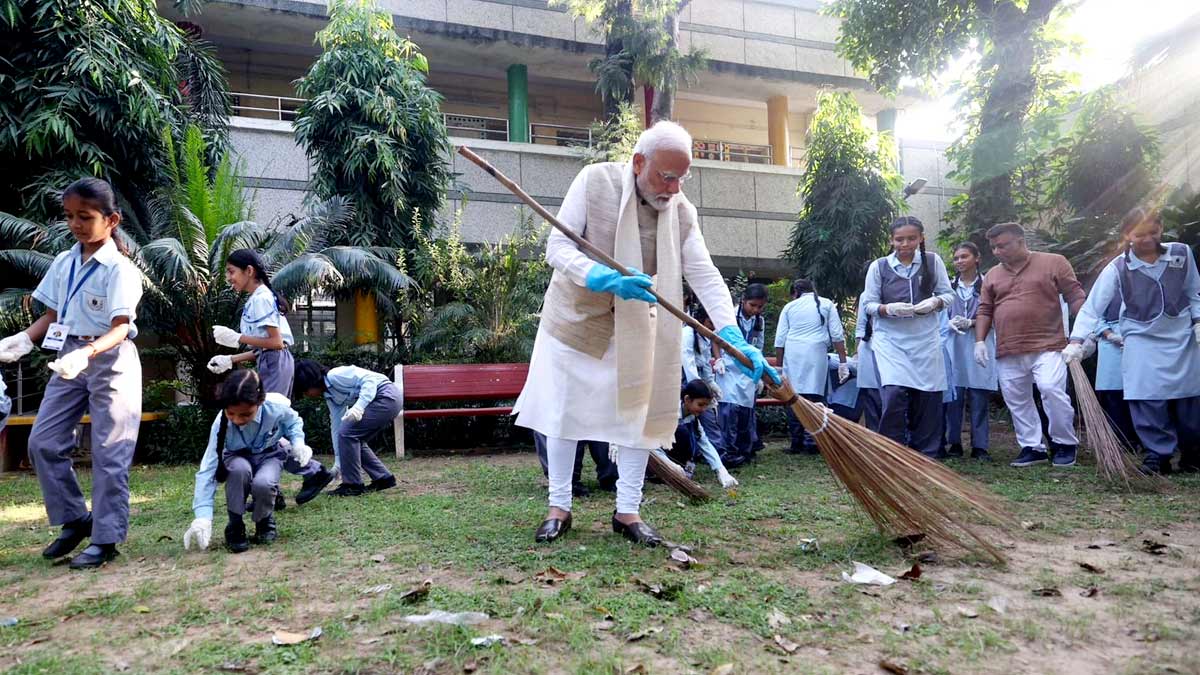Prime Minister Narendra Modi’s first Independence Day speech in 2014 was keenly watched. The country wanted to hear the new PM unveil his vision. Modi did not disappoint as he announced new initiatives, from building toilets to manufacturing in India to making the Ganga clean.
Within months, these key policies were rolled out, which have now completed 10 years – the Swachh Bharat Mission, Make in India and Namami Gange. THE WEEK looks at these three key projects.
Swachh Bharat Mission
The emphasis on building toilets and cleanliness was not something Prime Ministers had spoken about from the Red Fort. But it was an issue that the country needed to address not just at the policy level, but also in public perception. The idea has percolated to the grassroots level and nudged towards cleanliness a fairly-good success. Though the Swachh Bharat Mission has many components, including cleanliness, building toilets has been the transformational one.
In the last 10 years over 11 crore toilets have been built, Jal Shakti Minister CR Patil said that over 93 per cent women in the country have access to toilets, this means that over 60 crore women stopped going out to defecate.
The government allocated over Rs 32,000 crore for cleanliness programmes in the first five years. Citing the World Health Organization’s report, the minister said that every year 60,000-70,000 children who used to go out for defecation died due to diarrhoea. But the situation has changed now as no child dies of diarrhoea due to open defecation.
From Challenge to Change - #SwachhBharat 🚮🚰
— Central Railway (@Central_Railway) October 2, 2024
With 11.65 Cr+ toilets built and ODF villages, Swachh Bharat has redefined cleanliness, turning belief into reality. Witness the journey of a revolution that saves over 60k infant lives annually, setting a new benchmark for hygiene… pic.twitter.com/YyVQ6nl9bU
Prime Minister Modi will participate in Swachh Bharat Diwas 2024 programme on the occasion of the 155th Gandhi Jayanti on 2nd October to launch and lay the foundation stone for Rs 9600 crore projects on sanitation and cleanliness. It includes over Rs 6,800 crore for enhancing urban water and sewage systems, with 10 projects over Rs 1550 crore for improving water quality and waste management in Ganga basin areas under the National Mission for Clean Ganga.
Modi will use the 10th anniversary to talk about the next phase of national endeavour for cleanliness. Officials said under Swachhata Hi Seva 2024, over 19.70 lakh programmes have been completed with public participation of more than 17 crore people. “Transformation of around 6.5 lakh Cleanliness Target Units has been achieved. Nearly 1 lakh SafaiMitra Suraksha Shivirs have also een organised, benefitting over 30 lakh Safai Mitras. Further, over 45 lakh trees have been planted under the Ek Ped Maa ke Naam campaign.”
Make In India
The Make in India initiative aimed at making the country a manufacturing hub also completed 10 years. The program has played a role in boosting domestic manufacturing, pushing innovation, and facilitating foreign investment.
According to the government figures the Foreign Direct Investment (FDI) since 2014 has witnessed a cumulative inflow of USD 667.4 billion (2014-24), registering an increase of 119% over the preceding decade (2004-14). These investments have happened in 31 states and across 57 sectors. The FDI equity inflows into the manufacturing sector over the past decade (2014-24) reached USD 165.1 billion, an increase of 69% over the previous decade. Modi government launched the Production Linked Incentive (PLI) scheme to boost manufacturing in 2020, which has resulted in ₹1.32 lakh crore (USD 16 billion) in investments and a significant boost in manufacturing output of ₹10.90 lakh crore (USD 130 billion) as of June 2024. The government claims that over 8.5 lakh jobs have been created directly and indirectly due to the initiative.
Among other key reforms to boost manufacturing, a Semicon India Program, worth ₹76,000 crore, was initiated to provide an impetus to the semiconductor sector. The development of 11 industrial corridors under the National Industrial Corridor Development Programme has seen the approval of 12 new projects with a projected investment of ₹28,602 crore. These corridors enhance India’s competitiveness by providing world-class infrastructure.
The last decade has witnessed a sharp increase in start-ups as the number rose to recognised startups to 1,40,803 as of 30th June 2024, which official sources said have created over 15.5 lakh direct jobs.
जन चेतना में प्रखर रहे जल चेतना! स्वच्छता का संकल्प दुहरा रहे हैं हम, प्रतिदिन प्रतिपल।#10YearsOfSwachhBharat #SHS2024 #SwabhavSwachhata #SanskaarSwachhata #SwachhtaHiSeva #NamamiGange #CleanGanga #NahiRukengeSwachhKarenge @DoWRRDGR_MoJS @narendramodi @PMOIndia @CRPaatil… pic.twitter.com/gQkHYsF3zD
— Namami Gange (@cleanganganmcg) October 2, 2024
Namami Gange
The other programme which has completed 10 years is the Clean Ganga Mission (Namami Gange) whose deadline was till 2021 but has been extended till 2026. The programme included setting up of sewage treatment plants and other development activities. According to the government, a total of 467 projects, valued at 39080.70 crore, have been launched (till June), of these 292 projects have reached completion and are now operational. Of this 32409.23 crore has been sanctioned for these sewage infrastructure projects. Nearly 200 projects addressing sewage infrastructure have been set in motion. The mission has also undertaken biodiversity restoration projects. Given the massive work needed to make the holy river’s water clean, it is still work in progress.



